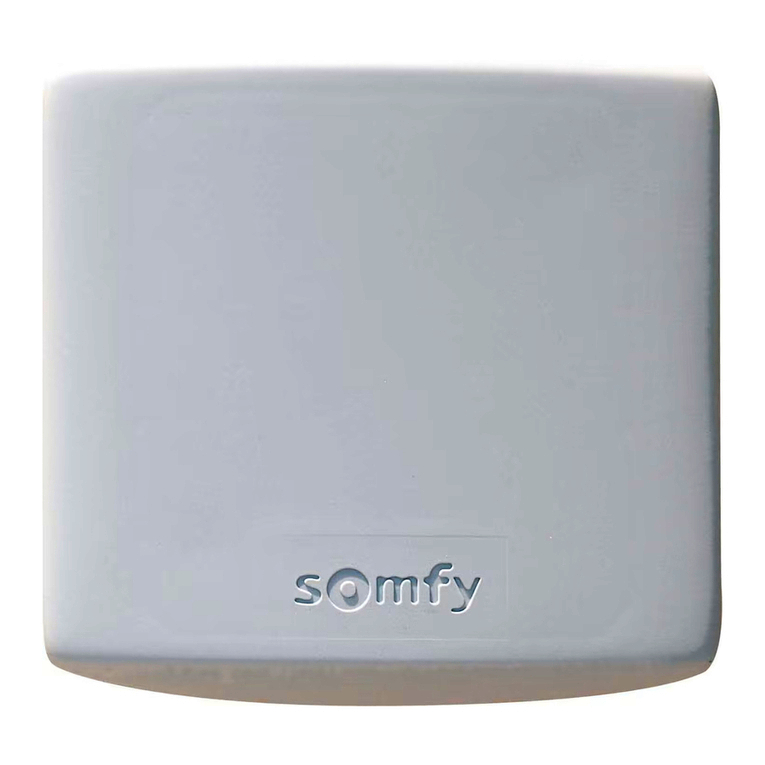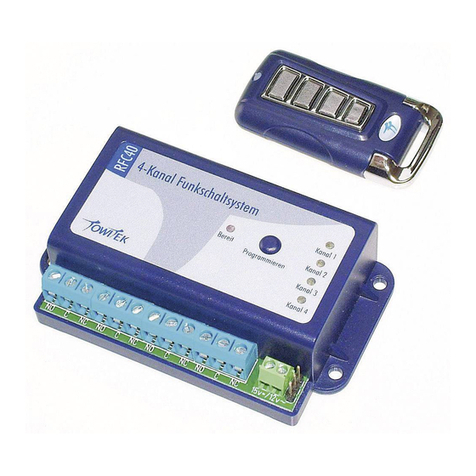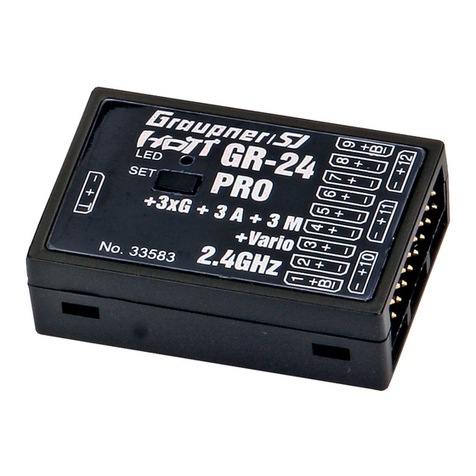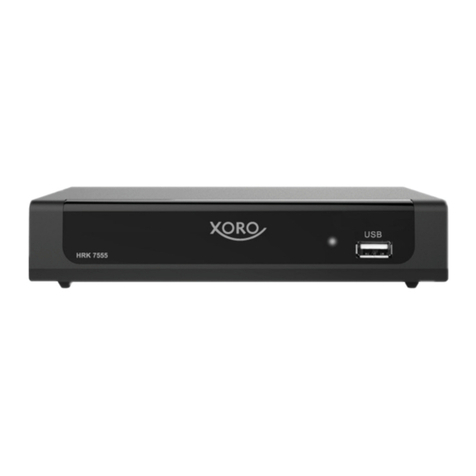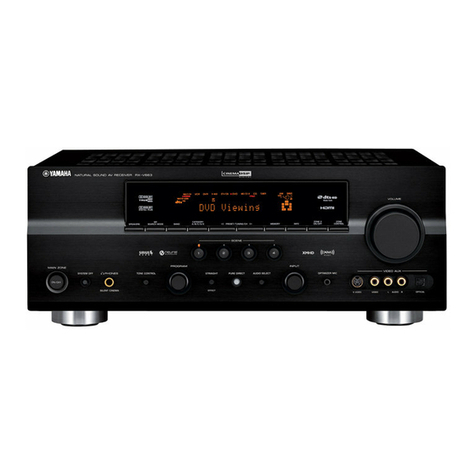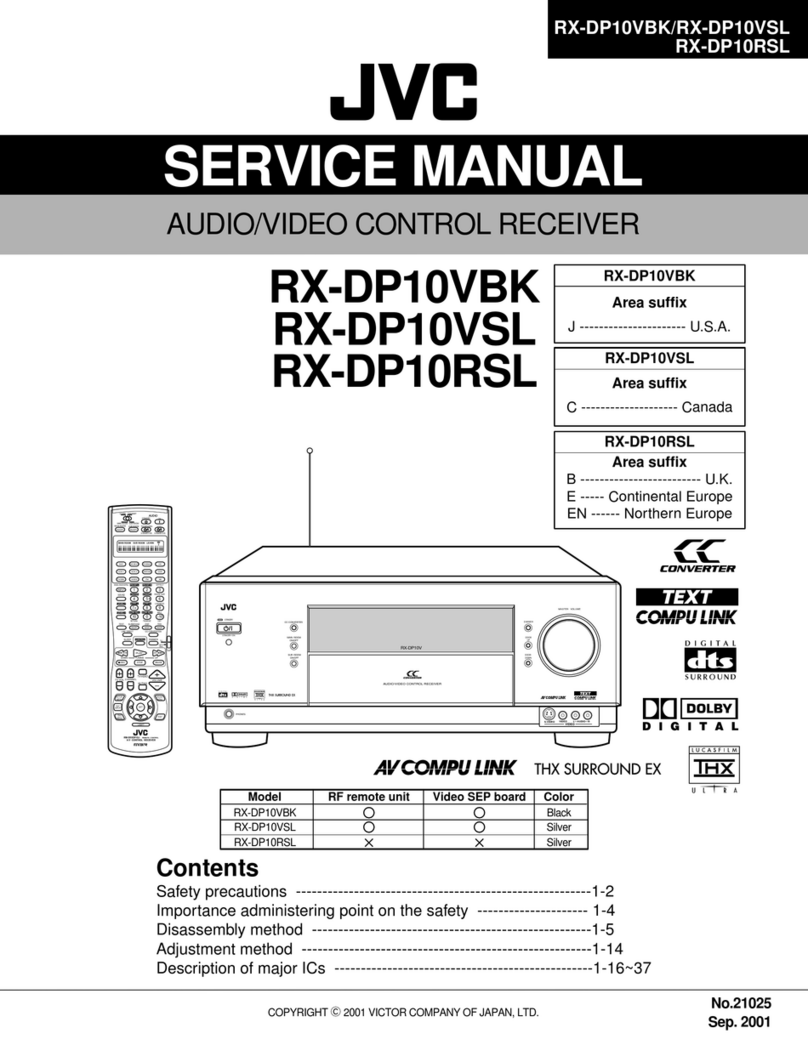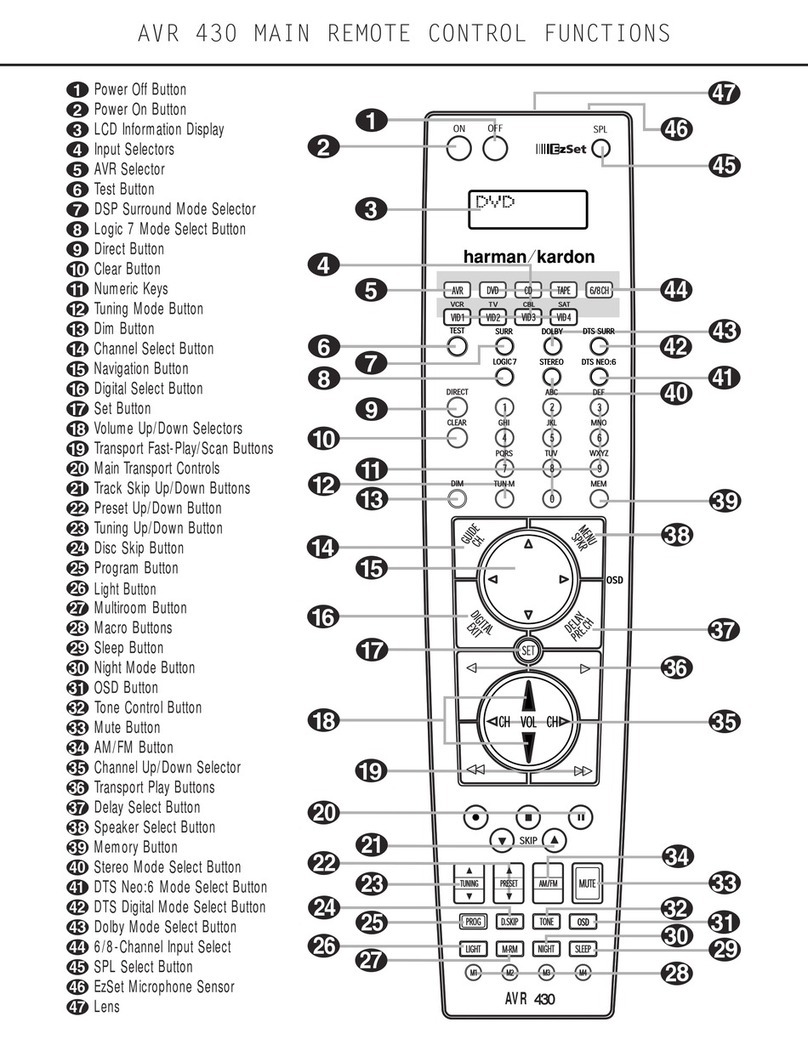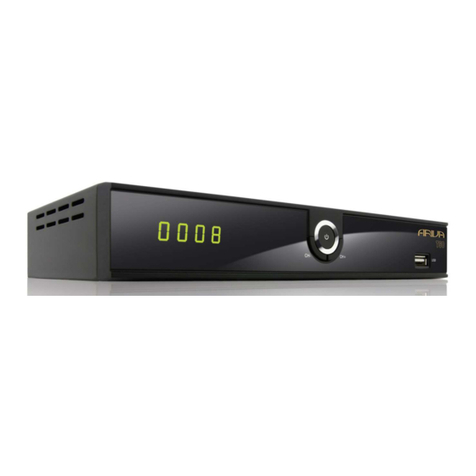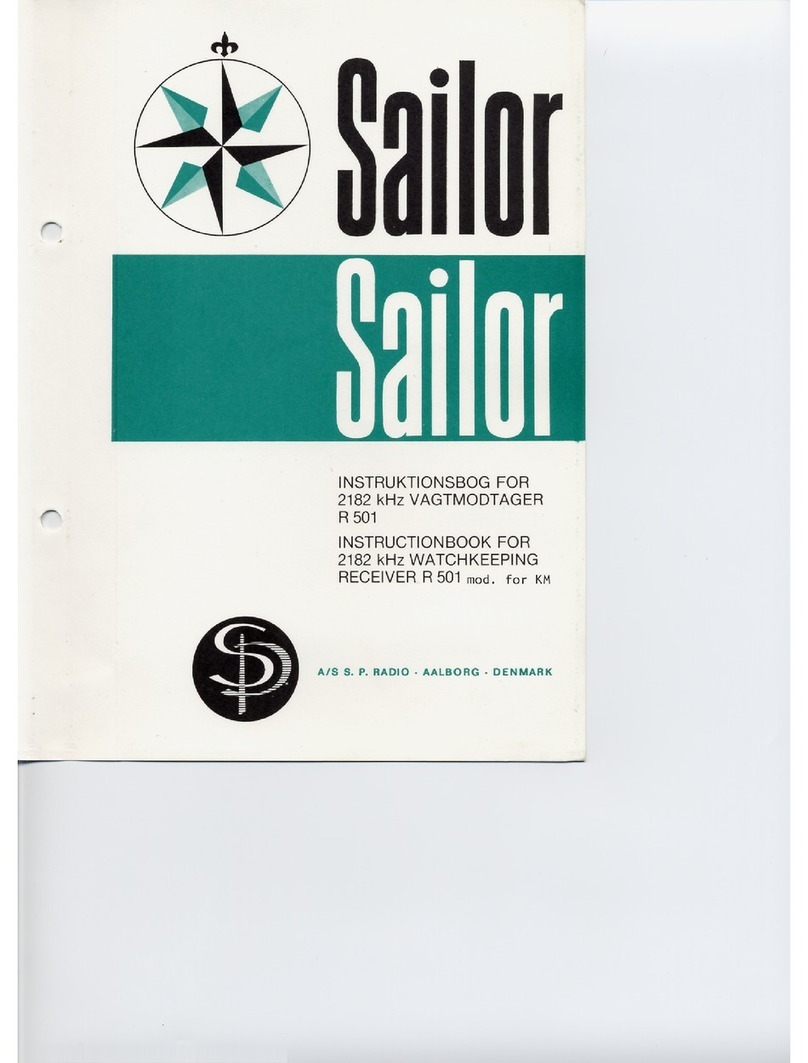New Communications Solutions NCS-3230 Multi-Rx User manual

NCS-3230
Multi-RxTM
INSTRUCTION MANUAL
Rev C
New Communications Solutions, LLC
5364 Valley Mist Trace
Suite 101
Norcross, Georgia 30092
Toll Free Tel. & Fax : 888- 883-5788
Web Site: www.ncsradio.com

NCS-3230 Rev C Instruction Manual Copyright © 2003, 2004 New Communications Solutions, LLC
2
Introduction
The Multi-RxTM was designed to provide a flexible way to monitor and control the
receive audio of multiple receivers. The Multi-RxTM works with any radios
including VHF/UHF scanners and transceivers and HF receivers and
transceivers. The Multi-RxTM provides selective monitoring of one to six radios
while allowing the operator to position the audio from each radio at distinct
locations in the audio field. Additionally, all radios can be muted (silenced) at the
push of a button. Provision is included for manual or automatic control of an
external digital or audio tape recorder. Any combination of the six radios can be
recorded and you can even record both sides of a QSO (provided your
transceiver has a “monitor” function). A unique Spatial mode lets you use only
two speakers but gives spatial separation of the audio from each radio which is
equivalent to having 6 individual speakers, one for each radio. In the Normal
mode, receive audio can be selectively positioned left, right or center in the audio
field.
The Multi-RxTM will benefit just about any ham shack. Its flexibility and versatility
make it ideal for contest stations, emergency operations, satellite stations,
repeater sites, mobile communications vans and any radio communications
environment.
Connecting to the NCS-3240 Multi-Switcher
For complete station control, the Multi-RxTM was designed to connect to the NCS-
3240 Multi-Switcher. The Multi-Switcher provides microphone switching for
transmitters as well as other functions. When both are used together, complete
transmit and receive control of multiple radios is achieved including automatic
muting of all radios when transmitting. There is also the ability to mute all radios
except the one being used. This feature is useful in HF setups where the
operator wants to monitor the transmitted audio using a radio’s built-in “monitor”
function.
NCS provides a full range of cables for connecting the Multi-RxTM to the Multi-
Switcher as well as microphone cables for most radios. Consult the NCS
website or call NCS to determine the correct cables for your specific
configuration.

NCS-3230 Rev C Instruction Manual Copyright © 2003, 2004 New Communications Solutions, LLC
3
1.0 Power Supply
1.1 Power Connector
The NCS-3230 Multi-RxTM will operate with any well-filtered 10-14 VDC
power supply capable of providing at least 200mA continuous, 1A peak.
The required power connector is a 2.1mm ID, 5.5mm OD coaxial power
plug. One power connector is supplied in the accessory pack with the
Multi-RxTM.
1.2 Polarity
The center pin of the coaxial power plug must be wired positive (+). If the
plug is wired backwards, the Multi-RxTM will not operate due to reverse
polarity protection built into the unit.
CAUTION:The Multi-RxTM was designed to work with voltages between
10-14 VDC. Voltages higher than 15V will cause an internal fuse in the
Multi-RxTM to open to protect certain components. (If the fuse opens, the
unit will need to be returned to NCS for out-of-warranty repair.) Most Wall
Power supplies on the market that are advertised as 12 VDC are not
regulated and may put out as much as 20 VDC when not connected to a
piece of equipment. The output voltage is reduced when powering
equipment depending on the current drawn by the equipment and the
internal resistance of the power supply. The internal resistance of the
power supply varies depending on manufacturer and model number. If
you are going to use a Wall Power Supply be sure it's output voltage,
when connected to the Multi-Switcher, does not exceed 14 VDC. The
NCS-1514 Wall Power Supply meets the requirements of the Multi-Rx.

2.0 Front Panel Controls and Indicators
2.1 POWER Switch
The power switch turns on all power to the Multi-RxTM. It has a yellow
LED in the paddle that is illuminated when the power is on. Note that the
Left and Right channel Radio Selections are maintained when the power
is off.
2.2 MUTE ALL
The MUTE ALL button will mute all radios when activated. The LED in the
button will blink as a reminder that all radios are muted.
2.3 Radio Select Switches
These switches are momentary pushbutton switches with LEDs. There is
a row of six switches for the Left channel (LEFT CH) and a row of six
switches for the Right channel (RIGHT CH). In the Normal mode, the top
row of switches select which radio(s) will be connected to the Left speaker
and the bottom row of switches select which radio(s) will be connected to
the Right speaker.
In the Spatial mode, the top row of switches turns on the audio of the
selected radio(s) in the appropriate position(s) in the sound field. The
bottom row of switches produces audio centered in the sound field for
selected radio(s) by sending the audio from the radio(s) equally to both the
Left and Right speakers.
2.4 BUSY Lights
These green LEDs will light up when audio is present from the respective
radio(s). It takes about 150mV peak from the radio(s) to activate the busy
lights.
NCS-3230 Rev C Instruction Manual Copyright © 2003, 2004 New Communications Solutions, LLC
4

NCS-3230 Rev C Instruction Manual Copyright © 2003, 2004 New Communications Solutions, LLC
5
2.5 RECORD SELECT Switches and LEDs
These switches select which radio(s) will be recorded. When a switch is
engaged (the “in” position), the corresponding yellow LED will light
indicating which radio will be recorded. Any or all radios can be recorded
simultaneously since the receive audio is mixed together inside the Multi-
RxTM.
2.6 RECORD Controls
The RECORD controls consist of two pushbutton switches and one red
LED. The ENABLE switch enables the recording function when pushed
in. When in the “out” position, no recording can occur regardless of the
settings of other controls.
With the RECORD function enabled, the MAN/VOX switch controls
whether recording will be signal activated (VOX) or always on (Man).
VOX operation depends on having enough audio level. The BUSY lights
indicate the signal level and if they are on, there is enough audio to
activate the VOX record function. There is a delay (5-10 sec) built in to
the drop out time of the VOX record function so the recorder will continue
to record during short pauses in the received audio.
When the record function is on and recording, the RECORD ON LED will
light.
2.7 SPEAKERS Switch
This switch turns the speakers on or off. The headphone output is always
active.
2.8 PHONES Jack
This jack is for use with a stereo headphone. Both channels of audio, Left
and Right, are present at all times unless one of the Mute functions is
activated.
2.9 BALANCE and VOLUME controls
These controls operate the same as on a consumer stereo system.
2.10 MODE Switch
This switch selects either the Normal or Spatial modes of operation. The
“in” position (S) selects Spatial mode; the “out” position (N) selects Normal
mode. See Section 4.2 for a description of the two modes.

3.0 Rear Panel
3.1 AUDIO IN Jacks
On the rear panel are six RCA phono jacks that connect the Multi-RxTM to
six different radios. These jacks are connected to the speaker output of
each radio. Signal level required for activation of the front panel BUSY
lights is approximately 150mV peak.
In the Spatial Mode, audio from radios 1-3 will appear in the sound field to
the left of center; audio from radios 4-6 will appear right of center. Note
the labeling of the top row “L” and the bottom row “R”.
3.2 MIXER OUT/AMP IN Jacks
The MIXER OUT and AMP IN jacks can be used to connect external
equipment such as equalizers, DSP filters or external audio amplifiers.
Note there are two pairs of jacks, one pair for the Left channel (L) and the
other for the Right channel (R). The MIXER OUT signal consists of
receive audio mixed as selected by the front panel switches. These
outputs are at “line” level – nominally 100-200 mV, The AMP IN signal
should also be at “line” level.
To use these jacks, two jumpers must be removed (one for each channel)
inside the Multi-RxTM. These internal jumpers normally connect the
MIXER OUT to the AMP IN signals when the rear panel jacks are not
being utilized. The following drawing shows the location of these jumpers
on the Main PC Board.
NCS-3230 Rev C Instruction Manual Copyright © 2003, 2004 New Communications Solutions, LLC
6

Remove these two jumpers to use
the Mixer Out/Amp In connections.
Main Board showing location of Mixer Out and Amp In Jumpers
3.3 SPEAKER Jacks
These jacks are for the left and right speakers. The Multi-RxTM was
designed for use with speaker impedance in the range of 4-16 Ohms. For
best results, both speakers should be the same type and impedance.
3.4 DATA Connector
The DATA connector is used for two purposes. The first is Selective
Muting. There is one input line on this connector for each of the six radios.
Selective Muting works in conjunction with the Mute jack to enable you to
mute all radios except one when you key PTT. To use selective muting,
the pin for any radio you DO NOT want to mute when transmitting, must
have a low (logic “0”) level (~0VDC). This can be a TTL or CMOS level or
a relay or switch closure to ground. The Selective Muting pinout is shown
below: Radio DATA connector
pin
1 1
2 4
3 6
4 7
5 8
6 9
Ground 5
NCS-3230 Rev C Instruction Manual Copyright © 2003, 2004 New Communications Solutions, LLC
7

NCS-3230 Rev C Instruction Manual Copyright © 2003, 2004 New Communications Solutions, LLC
8
The Selective Muting function was designed to be compatible with the
NCS-3240 Multi-SwitcherTM, giving you total Receive and Transmit control
of your station. See the NCS website for Application notes on using the
Multi-SwitcherTM with the Multi-RXTM.
The second function of the DATA connector is for external control of the
Multi-RxTM. Using this function, an external computer can read and set the
status of the front panel switches. Note that these signals are TTL/CMOS
level (0 to +5VDC) and must be converted to RS232 standard levels
(approx +12VDC to –12VDC) in order to connect the Multi-RxTM to a
computer.
Details of the data sent to and from the Multi-RxTM are shown in Section
4.4.
3.5 Recorder Connections
The RECORDER jacks are used to connect an external tape or digital
audio recorder to the Multi-RxTM. This function allows recording of any
radio(s) using either Manual or VOX operated control.
The AUDIO jack is a mini phone jack (1/8” or 3.5mm) and is normally
connected to the audio input of a recorder. The CNTRL jack is a sub-mini
(1/16” or 2.5mm) jack and is used to turn the recorder on and off. This
jack is isolated from ground and uses a dry relay closure so it can control
nearly any recorder.
3.6 MUTE Jack
The MUTE jack is an RCA phono jack. Bringing this input low (~0VDC)
causes all radios to be muted – except for any radios using Selective
Muting. Normally, this connector is tied in parallel with a PTT circuit.
3.7 PWR Connector
The PWR connector is a standard coaxial jack with 2.1mm pin and 5.5mm
shell dimensions.
3.8 Typical Connections
A diagram of typical connections is shown in Section 7 of this manual.

4.0 Operating with the Multi-Rx
4.1 Audio levels
Adjust the volume control on each connected receiver so that the
corresponding BUSY light is activated when received audio is heard.
4.2 Mode Selection
4.2.1 NORMAL mode
Moving the MODE Switch to the “out” position selects Normal
operation of the Multi-RxTM. In this mode, radios selected on the
top row of switches will be heard on the left speaker. Radios
selected on the bottom row of switches will be heard on the right
speaker. Radios selected on both rows of switches will be
connected to both speakers so they will be heard centered between
the two speakers. The Balance control can be adjusted to
compensate for the operator being closer to one speaker than the
other.
4.2.2 SPATIAL mode
Moving the MODE Switch to the “in” position sets Spatial operation
of the Multi-RxTM. In this mode, each radio has a pre-assigned
location in the audio field as shown below:
Selecting a radio with it’s corresponding top row button turns on it’s
audio in the pre-assigned location. Selecting a radio with the
bottom row of buttons sends the radio’s audio to both speakers
equally, thus centering the audio in the sound field.
NCS-3230 Rev C Instruction Manual Copyright © 2003, 2004 New Communications Solutions, LLC
9

NCS-3230 Rev C Instruction Manual Copyright © 2003, 2004 New Communications Solutions, LLC
10
4.3 Recording Function
To configure the Multi-RxTM for recording, connect a (tape or digital)
recorder to the RECORD jacks on the rear panel and enable recording by
setting the RECORD ENABLE switch to the “in” position. To record one or
more radios, press the RECORD SELECT switch for the desired radio(s).
For continuous recording regardless of whether there is activity or not, set
the MAN/VOX switch to the Man (in) position. In the VOX position, the
recorder will operate only when there is activity on the radio(s) selected for
recording. The VOX circuit is keyed to the BUSY lights so if the audio is
not strong enough to light the BUSY lights, then the VOX function won’t
turn on the recorder.
Note that you can record any radio(s) regardless of radio speaker
selection or mute functions. So even if a radio is not being heard through
a speaker, it can be recorded.
The red RECORD ON LED will light when actually recording. Note there
is an approximately 5 second dropout delay between the time activity
ceases and the recorder stops.
4.4 Computer Interfacing
The Multi-RxTM can communicate with an external computer using serial
data. When connecting to a computer, you will need to supply a TTL-to-
RS232 adapter to provide the proper signal levels for computer control of
the Multi-RxTM.
4.4.1 Electrical Interface
The Multi-RxTM has a DB9 female connector on the rear panel that
has the serial data transmit and receive lines. These lines are
TTL/CMOS level and must be converted to RS-232 levels for use
with most external computers. The serial data sent to and received
from the Multi-RxTM must be 8 bits, No Parity, 1 Stop Bit (8N1) at
1200 baud.
The serial data pinout on the Multi-RxTM is:
Signal DB9F DATA connector pin
RxD – TTL/CMOS level data from an
external computer 3
TxD – TTL/CMOS level data to an
external computer 2
Ground 5

4.4.2 Switch Status
The Multi-RxTM always sends the status of both rows of front panel
switches and the status of the MODE switch under the following
conditions:
• Power Up
• Change of status of any Radio Select Switch
• Change of the Mode Switch
• Receipt of a Status Inquiry command
The status is returned as two individual 8-bit bytes. Each byte is
defined as follows:
Bit 7 Bit 6 Bit 5 Bit 4 Bit 3 Bit 2 Bit 1 Bit 0
Channel
0 = Left
1 = Right
Mode Switch Status
0 = Spatial
1 = Normal
(only valid with Left
channel status byte)
Radio
6
Radio
5
Radio
4
Radio
3
Radio
2
Radio
1
4.4.3 Status Inquiry
To determine the current status of the front panel switches, send
the following command to the Multi-RxTM and it will respond with
two data bytes containing the status as shown in 4.4.2.
Bit 7 Bit 6 Bit 5 Bit 4 Bit 3 Bit 2 Bit 1 Bit 0
1 1 X X X X X X
X = Don’t Care
4.4.4 Set Command
To set the front panel switches, the following data is sent to the
Multi-RxTM:
Bit 7 Bit
6 Bit 5 Bit 4 Bit 3 Bit 2 Bit 1 Bit 0
Channel
0 = Left
1 = Right
0 Radio
6 Radio
5 Radio
4 Radio
3 Radio
2 Radio
1
Note: 1= On, 0=Off
NOTE: The MODE switch cannot be controlled remotely.
NCS-3230 Rev C Instruction Manual Copyright © 2003, 2004 New Communications Solutions, LLC
11

NCS-3230 Rev C Instruction Manual Copyright © 2003, 2004 New Communications Solutions, LLC
12
4.5 Hum, Noise and Distortion
Your Multi-RxTM was designed with care and uses high quality
components and construction. You should not experience any operating
difficulties when you follow the setup and use instructions in this manual.
If you do experience problems, here is some information that may help
you resolve any difficulties.
Hum
Magnetically induced hum can be caused to any modern piece of audio
equipment by too close proximity to unshielded power transformers or
other equipment that radiates strong AC magnetic fields. You can tell if
you have this type of hum by rotating the Multi-RxTM left/right, up/down
and moving its position. If the hum increases and decreases, then you are
experiencing magnetic coupling from an unshielded power transformer or
other equipment. The Multi-RxTM should be several inches away from
equipment that radiates AC magnetic fields.
Another source of hum can be a ground loop. This is a situation when
pieces of audio equipment that are connected together do not have their
grounds well connected. This results in a voltage difference between the
equipment grounds and can be a safety hazard as well as introducing
electrical problems. The solution to this problem is to tie all your
equipment grounds (usually case or chassis) together with a low
impedance RF connection. You should refer to any of the Amateur Radio
publications for extensive discussion of ground loops and how to eliminate
them.
Noise
Excessive noise can be caused by many factors. The Multi-RxTM uses
state-of-the-art low noise amplifier ICs. Nevertheless, even these
components can add a bit of noise or “hiss” to an audio signal if not
adjusted properly. If you seem to have excessive “hiss” type noise, review
the setup and level adjustments you’ve made to the radios connected to
the Multi-Rx.
Excessive noise can also be caused by ground loops. See the previous
“hum” discussion for information on eliminating ground loops.

NCS-3230 Rev C Instruction Manual Copyright © 2003, 2004 New Communications Solutions, LLC
13
Distortion
Distorted audio can be caused by one of two situations. The first and
most common is improper adjustment of audio levels. Be sure you’ve
adjusted the radio(s) volume controls as recommended in this manual.
RF in the shack can also cause distorted audio. To determine whether
this is the problem, connect your transmitter to a dummy load. If the
distortion disappears, then you have RF floating around the shack. To
eliminate RF problems, first make sure you have set up the jumpers and
radio cables correctly. Then check that you have a good ground between
all pieces of equipment and that your RF ground is low impedance. Refer
to any reliable Amateur Radio publication for detailed information on RF
problems and RF grounding.
5 Getting Help from NCS
NCS wants you to experience trouble free operation of our equipment. If
you have any questions, comments or need technical help, please use the
following resources:
1. Go to the web site, www.ncsradio.com.
Here you will find the latest instruction manuals, any factory
developed modifications and Frequently Asked Questions.
Be sure to include all pertinent information, e.g. make and
model of radios, how they’re connected to the Multi-SwitcherTM,
detailed description of any problems, antenna and grounding
configurations, etc.
3. Telephone us toll-free at 888-883-5788.
Be near your equipment and have the manuals for your radios
available. We will do our best to help you using our technical
expertise.

NCS-3230 Rev C Instruction Manual Copyright © 2003, 2004 New Communications Solutions, LLC
14
6 Multi-RxTM Specifications
F
ront Panel Controls and Indicators
• MUTE ALL Switch - Mutes all audio unconditionally.
• POWER Switch - Paddle Switch with Yellow Power Indicator LED
• Radio Selection Switches – Red LEDS light up when radio selected
Normal Mode
Top Row – Left Speaker
Bottom Row – Right Speaker
Spatial Mode
Top Row – Positions Radio(s) in Audio Field
Bottom Row – Centers Radio(s) in Audio Field
• BUSY Lights – Green LED(s) Flash with audio from corresponding radio(s).
• RECORD SELECT – Selects radio(s) for recording. Yellow LED indicators.
• BALANCE and VOLUME Controls – Control Left/Right speaker balance and
volume of both channels.
• MAN/VOX – Controls manual or VOX operation of record function.
• RECORD ENABLE – Enables recording. When off (out), no recording can
occur.
• RECORD ON LED – Lights when recorder is running.
• MODE Switch – Determines Normal (out) or Spatial (in) mode.
• SPEAKERS – Turns speakers off (out) and on (in).
• PHONES Connector – ¼ in (6.4 mm) stereo phone jack
R
ear Panel Connections
• AUDIO IN – Inputs from speaker jacks on radios. Approx 150mV required to
light BUSY LEDs.
• MIXER OUT – Line level outputs from internal mixers for both channels.
• AMP IN – Line level input to internal audio amplifier, both channels.
• SPEAKER OUT – Connect 4-16 Ohm speakers to these jacks.
• DATA – Selective Mute Inputs and Serial Data In /Out
• RECORDER
AUDIO – Line level audio output to recorder.
CNTRL – start/stop control of recorder. Dry relay contact, isolated from
ground.
• MUTE – RCA phono jack. When logic low (~0VDC) mutes all audio except
those programmed as Selective Mute.
• PWR – Coaxial, 2.1mm pin, 5.5mm shell, center pin positive
Power Requirements: 12-15 VDC @ 200 mA average, 1A peak.
Size: Approximately 8.3 x 6.2 x 3.3 inches

7 Typical Connections
RAD 1 RAD 2 RAD 3
RAD 4 RAD 5 RAD 6
AUDIO IN
R
L
L
R
SPEAKER
OUT
L
R
DATA
RECORDER
Audio
CNTRL
MUTE
PWR
12 VDC
New Communications Solutions, LLC
MODEL NCS-3230
3230
Mixer
Out Amp
In
New Communications Solutions, LLC
Norcross, GA 30092
Model Number
Serial Number
Tape
Recorder
Radio 1
Radio 4
Radio 2
Radio 5
Radio 3
Radio 6
Left Speaker Right Speaker
Typical Connections
12VDC
Power Supply
NCS-3230 Rev C Instruction Manual Copyright © 2003, 2004 New Communications Solutions, LLC
15

Off
Input from
Radio 1
Left
Both
Right
Left Amp
Right Amp
Balanc
eVolum
e
Left Speaker Out
Right Speaker Out
Input from
Radio 6
Left
Both
Right
Mixer
Mixer
Radio 2
Radio 3
Radio 4
Radio 5
Record Mixer
Record Audio
Line Out
Record Control
Record Radio 1
Record Radio 6
Audio
Detection
Busy Lights Man/
Vox
Record
Record
+V
Recording
LED
Off
VOX
MA
N
Functional Block Diagram - NORMAL Audio Mode
NCS-3230 Rev C Instruction Manual Copyright © 2003, 2004 New Communications Solutions, LLC
16

Off
Input from
Radio 1
Spatial
Both
Left Amp
Right Amp
Balance Volume
Left Speaker Out
Right Speaker Out
Input from
Radio 6
Spatial
Both
Mixer
Mixer
Radio 2
Radio 3
Radio 4
Radio 5
Record Mixer
Record Audio
Line Out
Record Control
Record Radio 1
Record Radio 6
Audio
Detection
Busy Lights
Man/Vox
Record
Record
+V
Recording
LED
Off
VOX
MAN
Functional Block Diagram - SPATIAL Audio Mode
Mixer
Virtual Speaker
Radio 1
Virtual Speaker
Radio 6
Virtual Speaker
Radio 5
Virtual Speaker
Radio 4
Virtual Speaker
Radio 3
Virtual Speaker
Radio 2
NCS-3230 Rev C Instruction Manual Copyright © 2003, 2004 New Communications Solutions, LLC
17

NCS-3230 Rev C Instruction Manual Copyright © 2003, 2004 New Communications Solutions, LLC
18
New Communications Solutions, LLC
Limited Product Warranty
All products manufactured by New Communications Solutions, LLC (hereafter referred to as NCS) and
purchased from an authorized dealer or purchased directly from NCS will be warranted to be free from
defects in material and workmanship for a period of one (1) year from the date of purchase.
NCS' liability under this warranty and the Customer's exclusive remedy is limited to repairing, servicing or
adjusting, and/or replacing the defective product returned to NCS within the warranty period. Whether the
defective product is repaired or replaced will be at the sole discretion of NCS. The warranty will be voided
for products that have been abused, misused, or subjected to abnormal operating conditions as determined
by NCS. Further, products damaged by lightning, power surges or force majeure events are not covered
under this warranty.
If, in the Customer's estimation the product appears to be defective and is within the warranty period NCS
should be notified as to the nature of the defect. If the product appears to be covered by the terms of the
warranty, NCS will promptly communicate a return authorization number and shipping instructions to the
Customer. When returning a product for repair/replacement under warranty the proof of purchase or a copy
thereof must be returned with the defective product. NCS at its discretion may deny warranty in the absence
of proof of purchase. Acceptable proof of purchase include bill of sale, cancelled check or credit card
receipt. Evidence of alteration of the proof of purchase document shall be reason to immediately void the
terms of the warranty.
For those products returned that prove to be defective and covered under the warranty, the Customer will
bear the cost of shipment for the return of the product to NCS. Collect shipments will not be accepted. NCS
will bear the cost of shipment for return of the product to the Customer after repair/replacement. Mode of
shipment for return to the Customer will be determined by NCS. Should examination reveal that the product
is not defective, NCS will notify the Customer and request return shipping instructions and NCS will be due
all shipping expenses. In the event that the examination reveals that the product is defective, but for any
reason is excluded from this warranty, NCS will prepare a quotation of the cost to repair, and will
communicate same to the Customer. In the latter event, NCS will be due all shipping charges incurred for
return of the product to the Customer.
The Customer may attempt to repair a defective product under warranty provided authorization to do so is
received from NCS Technical Support. NCS will supply replacement parts free of charge for authorized
Customer repairs provided that the defective part along with the proof of purchase is submitted to NCS.
NCS will pay postage and handling for replacement parts provided the above terms are met. The product
warranty under these circumstances will remain in force for the life of the warranty.
EXCEPT FOR THE EXPRESS WARRANTIES STATED IN THIS WARRANTY, WHICH
ARE EXCLUSIVE, NCS DISCLAIMS ALL WARRANTIES ON PRODUCTS SOLD
HEREUNDER, INCLUDING ALL IMPLIED WARRANTIES OF MERCHANTABILITY AND
FITNESS FOR A PARTICULAR PURPOSE. UNDER NO CIRCUMSTANCE IS NCS LIABLE
FOR CONSEQUENTIAL DAMAGES TO PERSON OR PROPERTY AS A RESULT OF THE
USE OF ANY NCS PRODUCTS.
The Customer may have additional rights beyond those specifically outlined in this document based on
individual state laws.
Table of contents
Other New Communications Solutions Receiver manuals

